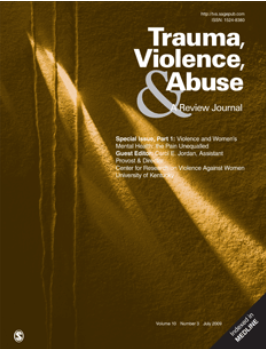The Frequency, Nature, Impact, and Coping Strategies of Nonconsensual Intimate Image Dissemination Victimization: A Scoping Review.
IF 5.4
1区 社会学
Q1 CRIMINOLOGY & PENOLOGY
引用次数: 0
Abstract
Young adults increasingly initiate, maintain, and end sexual relationships online, an evolution that has also transformed how sexual violence may be perpetrated. Nonconsensual intimate image dissemination (NCIID) has gained attention in research, policy, and media. Yet, to date, there has been no synthesis of the literature on NCIID victimization. The goals of this review were to: (a) describe the frequency and nature of NCIID victimization, (b) examine the impacts of experiencing NCIID, and (c) identify survivor coping strategies. Following the Preferred Reporting Items for Systematic Reviews and Meta-Analyses extension for Scoping Reviews (PRISMA-ScR) guidelines, PubMed, Scopus, Web of Science, and ProQuest were systematically searched for peer-reviewed qualitative, quantitative, and mixed-methods studies published in English by February 1, 2025. A total of 49 studies met the inclusion criteria. The reported frequency of NCIID ranged from 3% to 65%, with higher rates among those who experienced some other form of technology-facilitated sexual violence. Perpetrators were often current or former partners, and content was shared through both private messaging and public platforms. Victim-survivors frequently reported psychological (e.g., depression, anxiety, post-traumatic stress disorder), social (e.g., ostracism, victim-blaming), and academic/occupational harms. Help-seeking strategies included disclosing to trusted others, legal action, and content reporting, while coping through avoidance strategies included relocation, withdrawal, or trying to act as if nothing happened. Barriers to help-seeking included stigma, lack of awareness, and prior negative experiences with authorities. Findings highlight the urgent need for survivor-centered support systems, awareness campaigns, and broader conversations about consent in digitally mediated sexual encounters.非自愿性亲密图像传播受害的频率、性质、影响和应对策略:一个范围综述。
年轻人越来越多地在网上发起、维持和结束性关系,这一演变也改变了性暴力的实施方式。非自愿亲密图像传播(Nonconsensual intimate image dissemination, NCIID)已经引起了研究、政策和媒体的广泛关注。然而,到目前为止,还没有关于NCIID受害的综合文献。本综述的目的是:(a)描述NCIID受害的频率和性质,(b)检查经历NCIID的影响,以及(c)确定幸存者应对策略。根据系统评价和荟萃分析扩展范围评价(PRISMA-ScR)指南的首选报告项目,PubMed、Scopus、Web of Science和ProQuest系统地检索了2025年2月1日之前发表的同行评议的定性、定量和混合方法的英文研究。共有49项研究符合纳入标准。据报道,NCIID的发生率从3%到65%不等,在那些经历过其他形式的技术促进性暴力的人中,发生率更高。犯罪者通常是现任或前任伴侣,内容通过私人信息和公共平台共享。受害者-幸存者经常报告心理(例如,抑郁、焦虑、创伤后应激障碍)、社会(例如,排斥、受害者责备)和学术/职业伤害。寻求帮助的策略包括向信任的人披露、法律行动和内容报告,而通过回避策略应对的策略包括搬迁、撤离或假装什么都没发生。寻求帮助的障碍包括耻辱、缺乏认识以及先前与当局的负面经历。研究结果强调,迫切需要建立以幸存者为中心的支持系统,开展宣传活动,并就数字媒介性接触中的同意进行更广泛的对话。
本文章由计算机程序翻译,如有差异,请以英文原文为准。
求助全文
约1分钟内获得全文
求助全文
来源期刊

Trauma Violence & Abuse
Multiple-
CiteScore
13.60
自引率
7.80%
发文量
131
期刊介绍:
Trauma, Violence, & Abuse is devoted to organizing, synthesizing, and expanding knowledge on all force of trauma, abuse, and violence. This peer-reviewed journal is practitioner oriented and will publish only reviews of research, conceptual or theoretical articles, and law review articles. Trauma, Violence, & Abuse is dedicated to professionals and advanced students in clinical training who work with any form of trauma, abuse, and violence. It is intended to compile knowledge that clearly affects practice, policy, and research.
 求助内容:
求助内容: 应助结果提醒方式:
应助结果提醒方式:


